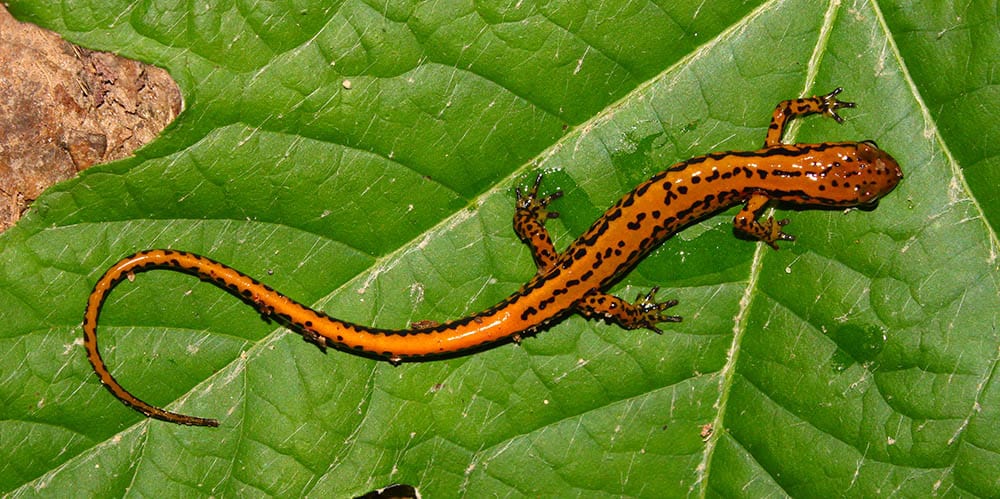South Carolina is home to amazing weather, beaches, and yes, Salamanders. The Palmetto State is actually home to about 49 different kinds of Salamanders. Just like the unique state they come from, these Salamanders range in size from just under 2 inches and upward to 4 feet!
Due to the sheer number of them, we focus on the most common Salamanders of South Carolina.

The 16 Salamanders Found in South Carolina
1. Blackbelly Salamander

| Species: | Desmognathus quadramaculatus |
| Longevity: | 15 years |
| Good to own as a pet?: | No |
| Legal to own?: | Yes |
| Adult size: | 3.9–6.9 inches |
| Diet: | Carnivorous |
Blackbelly Salamanders (also called Black-Bellied) are members of the lungless Salamander family. They are among the largest of the stream Salamanders in the southeast. They are black or dark brown with two horizontal rows of light-colored spots along their sides, and they have black bellies.
These Salamanders are aquatic, so you’ll typically find them near water and hiding under rocks during the day. They can be found in and near water, where there are also many rocks and small streams.
They hunt at night and eat crayfish, aquatic worms, and primarily aquatic larva. Blackbellies are prey for shrews, garter and water snakes, spring Salamanders, and crayfish.
2. Dwarf Waterdog

| Species: | Necturus punctatus |
| Longevity: | 10+ years |
| Good to own as a pet?: | Yes |
| Legal to own?: | Yes |
| Adult size: | 4.5–7.5 inches |
| Diet: | Carnivorous |
Dwarf Waterdogs are from the mudpuppy and waterdog family. They are gray, brown, or black on the top with a whitish throat and belly but without any obvious markings. They have reddish frilled gills that extend away from the body.
They prefer slow-moving water, such as swamps, streams, flooded fields, irrigated ditches, and blackwater bodies of water.
They feed on crustaceans, aquatic insects, and worms, and while there aren’t any known specific predators for Dwarf Waterdogs, they likely fall victim to larger Salamanders, snakes, crayfish, and aquatic insects.
3. Jordan’s Salamander

| Species: | Plethodon jordani |
| Longevity: | 10 years |
| Good to own as a pet?: | Unknown |
| Legal to own?: | Yes |
| Adult size: | 3.5–5 inches |
| Diet: | Omnivorous |
Jordan’s Salamanders (also known as Red-Cheeked or Red-Legged Salamanders) are lungless and can be black or gray but have red cheek patches or red legs. They can be mistaken for the Slimy Salamander but are smaller and don’t have the same white flecks.
They can be found under decayed logs and rocks in humid forests and are commonly observed in mountains and woodlands.
They hunt insects, worms, and mollusks on wet nights but will also consume vegetation on dry evenings. Garter snakes are the biggest threat to Jordan’s Salamanders, as well as the occasional predator birds.
4. Long-Tailed Salamander
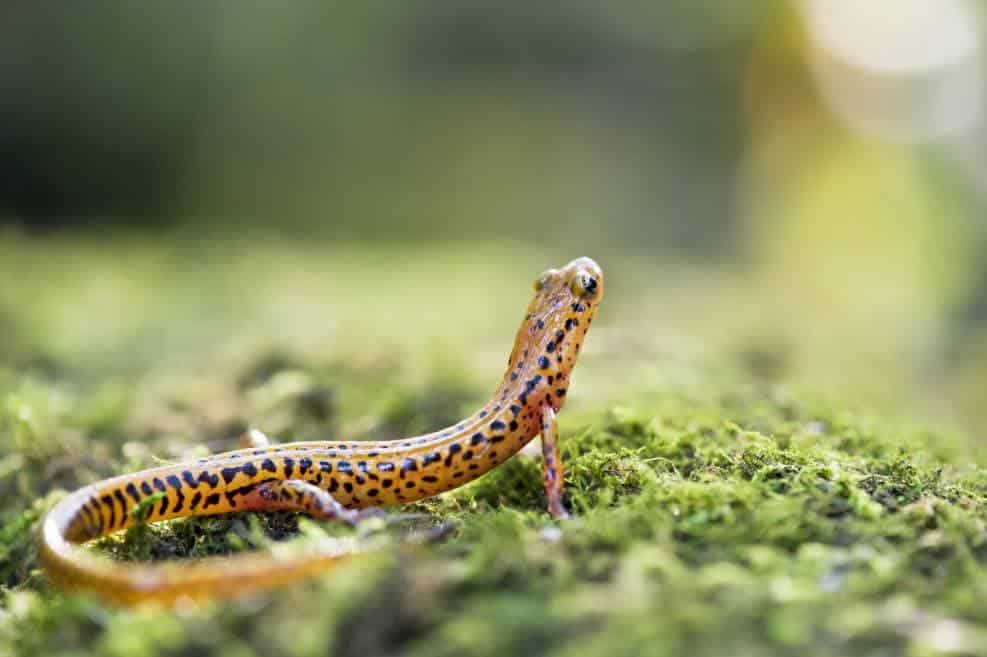
| Species: | Eurycea longicauda |
| Longevity: | 10 years |
| Good to own as a pet?: | Yes |
| Legal to own?: | Yes |
| Adult size: | 4–8 inches |
| Diet: | Carnivorous |
Long-Tailed Salamanders are one of the largest of the Eurycea Salamanders and are lungless. They have long tails that are a little more than half of their body length and range from a yellow to a darker orange color with lines of black spots.
Like most Salamanders, they prefer hiding under logs, leaf litter, and rocks during the day and are found near streams, springs, mine shafts, and caves.
They typically consume young and adult arthropods, worms, and other insects and can be preyed on by certain species of fish, such as the sunfish and the sculpins. The tail can break off when they feel threatened, as they run for cover.
5. Marbled Salamander

| Species: | Ambystoma opacum |
| Longevity: | 4–10 years |
| Good to own as a pet?: | Yes |
| Legal to own?: | Yes |
| Adult size: | 3.5–4.25 inches |
| Diet: | Carnivorous |
Marbled Salamanders are members of the —ole Salamander family and are quite striking, with dark brown or black bodies and silvery or white crossbands that cover the head, body, and tail. The male’s crossbands tend to be white, whereas the female’s bands are gray or silvery.
They tend to live in wooded hillsides and floodplains, burrow under logs close to streams or ponds, and prefer a moist environment.
They eat snails, slugs, insects, and small worms but only live prey. They are preyed upon by woodland predators such as skunks, raccoons, snakes, owls, and shrews. They have venom glands on their tails for some protection.
6. Mole Salamander
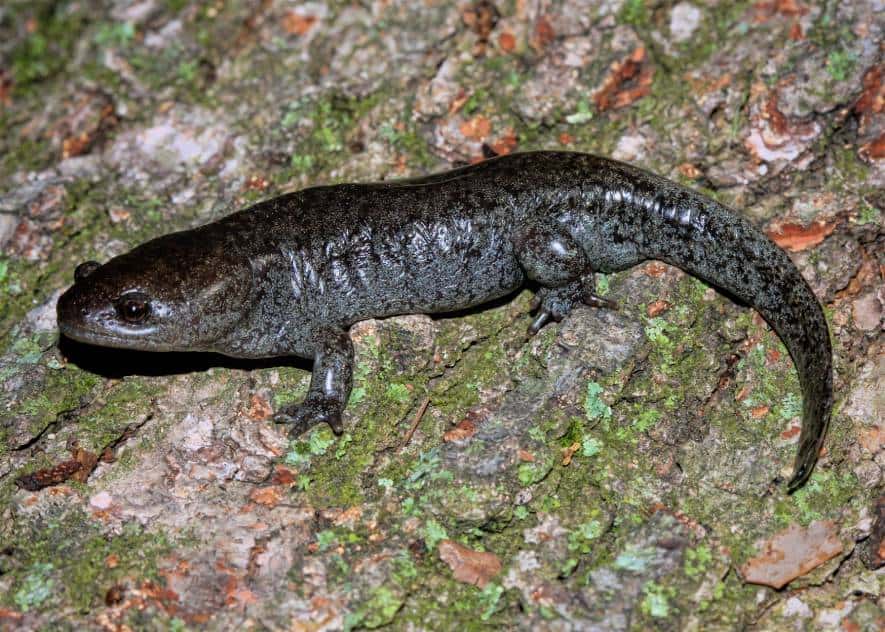
| Species: | Ambystoma talpoideum |
| Longevity: | 3–10 years |
| Good to own as a pet?: | No |
| Legal to own?: | Yes |
| Adult size: | 3–4 inches |
| Diet: | Carnivorous |
Mole Salamanders are members of the mole Salamander family. They are brown, gray, or black with pale silvery or bluish flecks. They are rather stout Salamanders with large, flattened heads.
They are found in forests, particularly sandy pine forests, and occasionally under leaf litter or logs. Some Mole Salamanders will retain their larval characteristics even as adults and will continue to live in the water, but they might also metamorphose and live on land.
Mole Salamanders will eat Mole Salamander eggs or those of other Salamanders, as well as midge larva, water fleas, tadpoles, earthworms, and more (depending on the life stage). Predators include other Salamanders, particularly the Marbled Salamander, and the Bluegill sunfish.
7. Northern Dusky Salamander
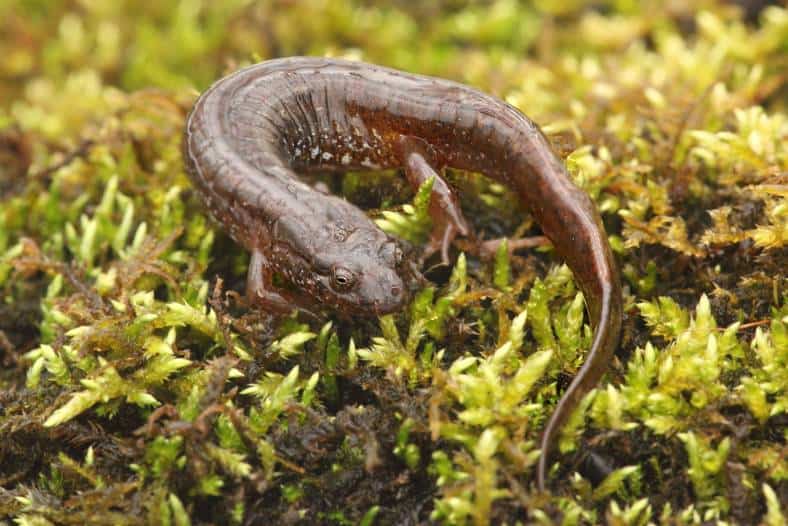
| Species: | Desmognathus fuscus |
| Longevity: | Up to 15 years |
| Good to own as a pet?: | Yes |
| Legal to own?: | Yes |
| Adult size: | 2.5–5 inches |
| Diet: | Carnivorous |
Northern Dusky Salamanders are in the lungless category. They are brown to a reddish-brown or olive or gray with dark markings. The base of their tails tends to be lighter in color, and their bellies are whitish with dark speckles.
They can be found in partially or fully wooded humid habitats with slower-running sources of water. They prefer to hide under logs and flat rocks near streams or seeps that are rocky or on hillsides and near waterfalls.
They eat spiders, crustaceans, earthworms, snails, ants, moths, etc. and are prey to raccoons, garter and water snakes, shrews, Spring and Red Salamanders, and birds. They drop their tails when threatened, which can grow back.
8. Red Salamander

| Species: | Pseudotriton ruber |
| Longevity: | 20 years |
| Good to own as a pet?: | Yes |
| Legal to own?: | Yes |
| Adult size: | 4–6 inches |
| Diet: | Carnivorous |
Red Salamanders are additions to the lungless Salamander family and can be an orangish-red to a bright red with black spots.
They prefer small creeks, springs, and streams but can also be found in forests. They take shelter under logs, rocks, and leaf litter.
They enjoy a diet of other Salamanders, as well as water beetles, spiders, slugs, and earthworms. They can be prey to raccoons, birds, shrews, skunks, snakes, and other Salamanders.
9. Red-Spotted Newt

| Species: | Notophthalmus viridescens |
| Longevity: | 15 years |
| Good to own as a pet?: | Yes |
| Legal to own?: | Yes |
| Adult size: | 3–5 inches |
| Diet: | Carnivorous |
Red-Spotted Newts are also known as Eastern Newts. They begin life a bright red or orange color, but once they metamorphose into adults, they change to a yellowish-green, with small red spots usually outlined in black.
They typically live in forests and small bodies of fresh water, such as marshes, small lakes, ditches, and ponds.
They eat aquatic insect larva, mollusks, worms, and midge larva. They are prey to birds, fish, mammals, and amphibians, but their skin secretions are toxic, which affords them protection.
10. Slimy Salamander
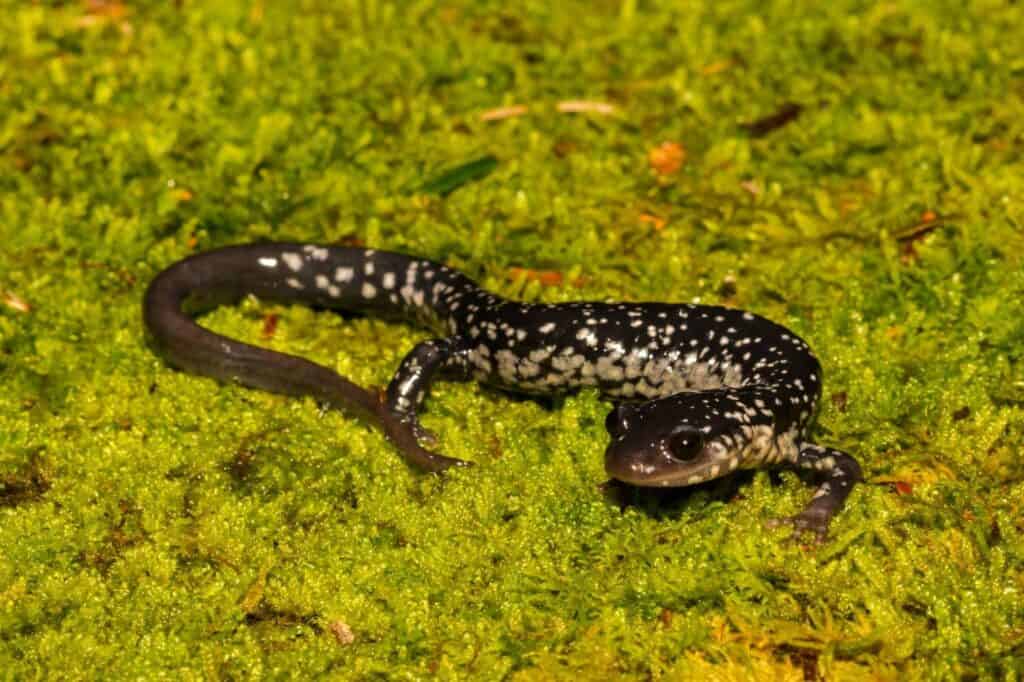
| Species: | Plethodon glutinosus complex |
| Longevity: | 5.5 years |
| Good to own as a pet?: | Yes |
| Legal to own?: | Yes |
| Adult size: | 4.75–6.75 inches |
| Diet: | Carnivorous |
Slimy Salamanders are yet another lungless Salamander. They are large and are a black-blue color with silvery or gold spots.
They can be found in woodlands and ravines that are moist and undisturbed and will stay under rocks, decaying logs, and debris during the day.
They eat primarily ants, followed by beetles, earthworms, and sowbugs. They are called “slimy” because of the slimy and almost glue-like secretions that they excrete when threatened.
11. Southern Appalachian Salamander
| Species: | Plethodon teyahalee |
| Longevity: | 5 years |
| Good to own as a pet?: | No |
| Legal to own?: | Yes |
| Adult size: | 4.75–6.75 inches |
| Diet: | Carnivorous |
Southern Appalachian Salamanders are of the lungless variety and are black with silver or white flecks covering their bodies.
They are typically found in moist or humid forests and can be found under rocks, decaying logs, and in cracks and crevices along streams.
They hunt for small insects such as beetles, flies, ants, millipedes, moth larvae, and snails. Like Slimy Salamanders, they produce a slimy and glue-like substance when threatened.
12. Southern Two-Lined Salamander
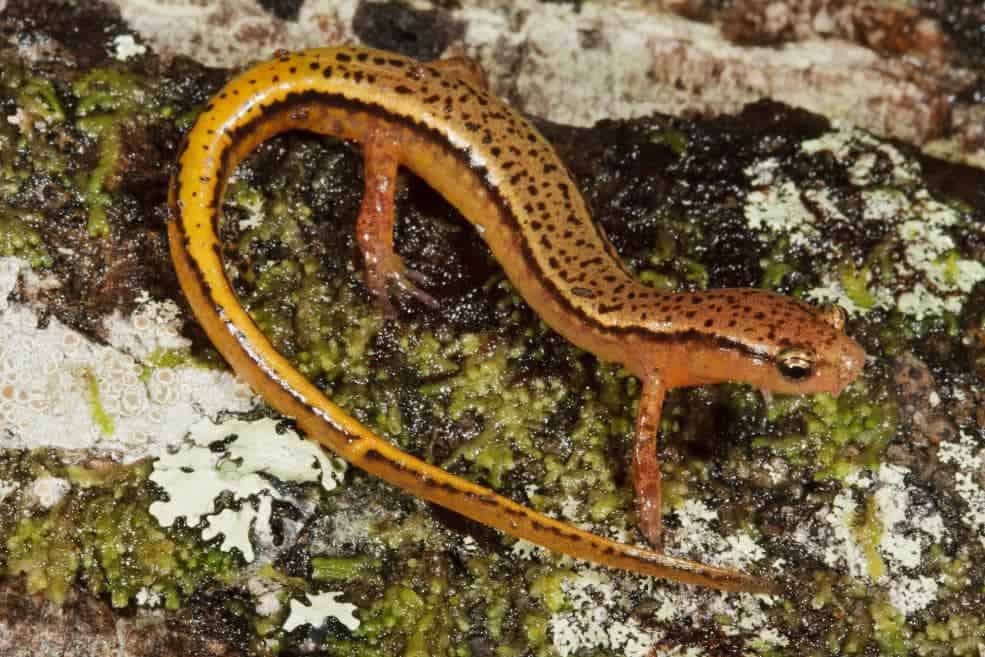
| Species: | Eurycea cirrigera |
| Longevity: | 9+ years |
| Good to own as a pet?: | Yes |
| Legal to own?: | Yes |
| Adult size: | 2.5–3.75 inches |
| Diet: | Carnivorous |
Southern Two-Lined Salamanders are more of the lungless variety of Salamanders and are a tan to pale yellow, with a pair of black stripes that run from the tail to the eyes.
They prefer creeks and streams in shallow areas underneath woody debris for cover.
They hunt insects, mollusks, crustaceans, spiders, roaches, earthworms, ticks, millipedes, and so on. They are preyed on by birds, fish, ring-necked and garter snakes, and other Salamanders.
13. Spotted Salamander

| Species: | Ambystoma maculatum |
| Longevity: | 20 years |
| Good to own as a pet?: | Yes |
| Legal to own?: | Yes |
| Adult size: | 6–9.5 inches |
| Diet: | Carnivorous |
Spotted Salamanders belong to the Mole Salamander family and are gray, black, or brown, with two rows of yellow and orange spots along the back. These Salamanders have had the honor of being the state Salamander of South Carolina since 1999.
They can be found in deciduous forests along rivers but can also be found in ponds and swamps, where they will burrow near the water.
They eat snails, slugs, millipedes, spiders, and smaller Salamanders, using their sticky tongues to catch their prey. They are prey to turtles, raccoons, birds, snakes, frogs, and newts and use toxins for protection.
14. Spring Salamander
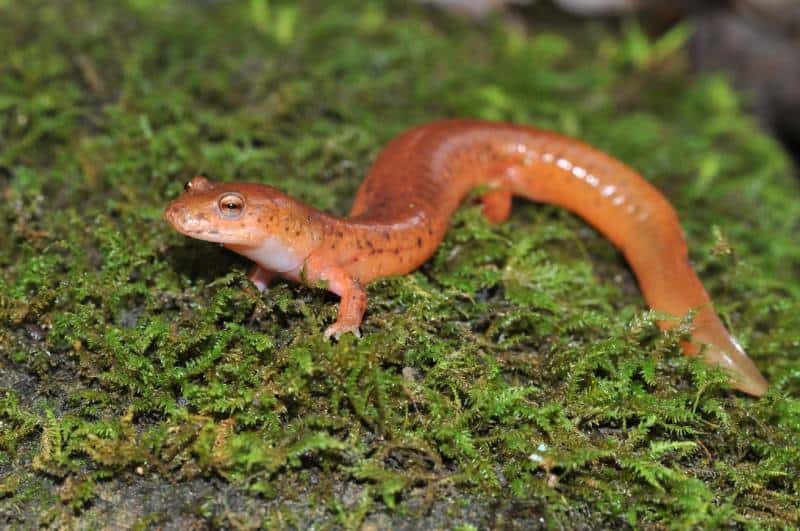
| Species: | Gyrinophilus porphyriticus |
| Longevity: | 18.5 years |
| Good to own as a pet?: | No |
| Legal to own?: | Yes |
| Adult size: | 5–7.5 inches |
| Diet: | Carnivorous |
Spring Salamanders are lungless and are slim with a yellow-brown to salmon color and hints of red.
They prefer creeks and springs that are cool and clear but can occasionally be found in humid forests. During the day, they take cover under logs and rocks and can sometimes be seen crossing roads on wet and rainy nights.
They eat centipedes, earthworms, spiders, snails, and the occasional small frogs and Salamanders, even other Spring Salamanders.
15. Three-Lined Salamander

| Species: | Eurycea guttolineata |
| Longevity: | 5 years |
| Good to own as a pet?: | Yes |
| Legal to own?: | Yes |
| Adult size: | 4–6.25 inches |
| Diet: | Carnivorous |
Three-Lined Salamanders are lungless and are a tan to pale yellow color, with three black stripes (hence the name) that run the length of the body from the tail to the eyes. Their tails are also quite long at two-thirds the body length.
They can be found near swamps and by streams in hardwood forests. They, like most Salamanders, spend time under rocks, logs, and other covers next to blackwater swamps and streams.
They prey on invertebrates, including spiders, millipedes, snails, and other insects. They are prey to small animals, birds, and snakes and will use the tail-breaking-off defense mechanism when in danger.
16. Tiger Salamander
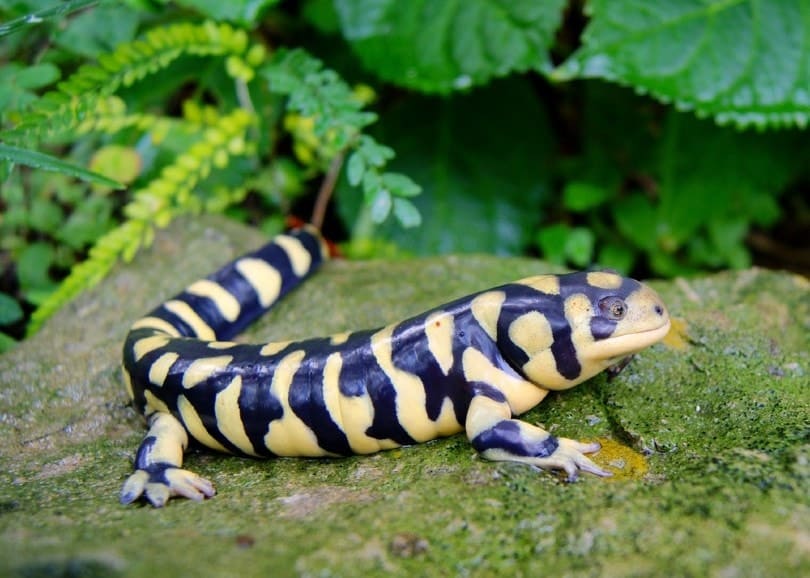
| Species: | Ambystoma tigrinum |
| Longevity: | 25 years |
| Good to own as a pet?: | Yes |
| Legal to own?: | Yes |
| Adult size: | 6–8 inches |
| Diet: | Carnivorous |
Tiger Salamanders are members of the Mole Salamander family. They are black with yellow spots or large blotches and the occasional stripes or bands (although sometimes, the spots are olive green or tan).
They live in grasslands, forests, and marshy locations but tend to burrow into the ground for the proper humidity levels. They also seek out small water areas such as ponds.
They eat snails, slugs, worms, insects, smaller frogs, and Salamanders. They are preyed on by snakes, bobcats, owls, and badgers and protect themselves by excreting a toxic substance from their tails.

Conclusion
Unfortunately, many Salamanders are uncommon and endangered due to the loss of habitat. This is unfortunate because they are useful little amphibians. They prey on insects, which can help minimize damage to crops and gardens.
We hope that you’ve enjoyed learning a little more about the Salamanders of South Carolina. Not only are they cute but they’re also helpful!
Featured Image Credit by Jason Patrick Ross, Shutterstock
